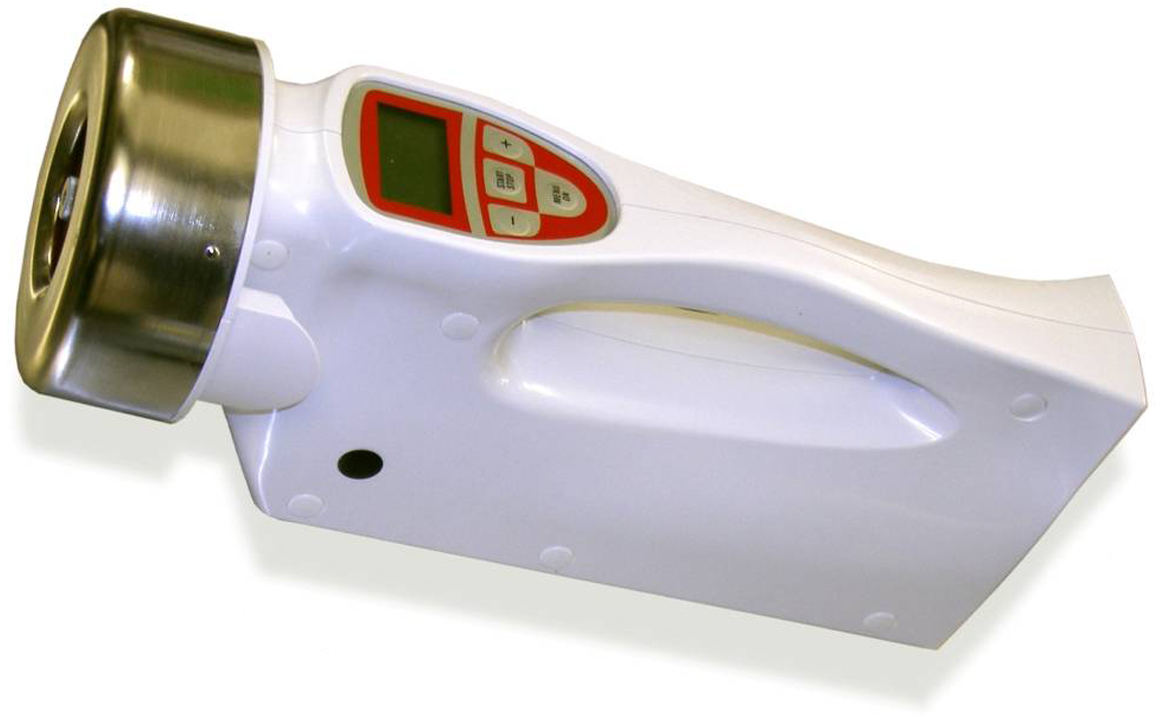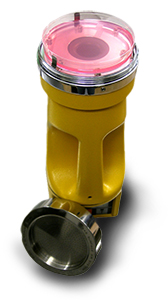IAQ analysis, quantitative fungal culture [FC-A]
Published: July 8th, 2009
Revised: March 21st, 2023
Culture-dependent air sampling remains a mainstay of fungal air sampling. Culture-based methods involve the collection of airborne particles by impaction or centrifugation on the surface of a growth medium. The airborne burden of culturable fungi is then extrapolated based on the colony counts obtained after incubation of the sampled media. Culturable air sampling results are usually expressed in Colony Forming Units per cubic metre air (CFU/m³). Although these techniques cannot be used to evaluate human exposure, they are often useful in detecting the presence of indoor fungal contamination. Unlike spore trap sampling, because counts are derived from actively growing colonies, culture-based air sampling affords an ability to identify recovered colonies to a very low level, often to the species level. Culture-based sampling methods do however have several notable limitations, as outlined below.
Methodological limitations
- Sampling intervals must remain brief to minimize osmotic changes in sampling media during collection. In contrast to more integrative sampling techniques possible in spore trap sampling, the use of brief sampling periods increases the influence of transient airborne spore bursts on sample results.
- Standard growth media are selective in their nature, and may not equally support the growth of all fungi present in the air at a given time. Many commonly occurring airborne fungi have specific nutritional requirements that cannot be satisfied by a single general purpose growth medium. Others may be entirely “non-culturable” (e.g. powdery mildew fungi in the genus Erysiphe and others). The growth media typically recommended for culture-based air sampling are intended to optimize recovery of the most relevant subset of the problem indoor fungi.
- A large proportion of the fungal content of air is non-culturable and thus cannot be detected by this sampling method.
- Long incubation times are often necessary to obtain sufficient growth and sporulation to permit accurate identification (e.g. 7-21 d). Attempts to expedite this process by shortening the incubation time or increasing the incubation temperature tend to bias the outcome by selecting for rapidly-growing fungi or thermophilic species, respectively.
 Culture-based sampling is a useful investigative tool to help determine the presence of indoor fungal growth. Culture-dependent sampling is the preferred air sampling technique when low level fungal identifications are required (e.g. to the species-level). This method is also useful where high levels of non-fungal background particulate may be present that would interfere with spore trap testing. Several commercially available sampling instruments can be used for culture-based air sampling, including the RCS Standard and RCS High Flow, Anderson N6 and 2-stage samplers and the Surface Air Sampler (SAS).
Culture-based sampling is a useful investigative tool to help determine the presence of indoor fungal growth. Culture-dependent sampling is the preferred air sampling technique when low level fungal identifications are required (e.g. to the species-level). This method is also useful where high levels of non-fungal background particulate may be present that would interfere with spore trap testing. Several commercially available sampling instruments can be used for culture-based air sampling, including the RCS Standard and RCS High Flow, Anderson N6 and 2-stage samplers and the Surface Air Sampler (SAS).
Field collection method
-
- Prior to use, the sampling head and exterior of the device should be disinfected with 70% isopropyl alcohol and allowed to dry. This treatment will help to prevent carry-over contamination from previous usages. As well, a clearly-defined sampling plan should be constructed before beginning sampling.
- Verify that the expiration date on the sampling medium is current, and that there is no evidence of damage to the surface of the collection medium (e.g. drying or cracking, colour changes, small glistening, pasty or fuzzy dots that might be microbial colonies, or free water on the medium surface)

RCS YM strip (above), containing a proprietary Rose Bengal Agar
- Insert the sampling medium into the air sampler following manufacturer’s recommendations. Wear latex or nitrile gloves during this process to prevent handling contamination.
- Turn the sampler or sampling pump on to initiate air flow. Flow rates of most units are predefined by the manufacturer of the device. These tend to be in the range of 25-60 L/min. The duration of sampling is usually the only user-controlled variable. During summer months, sample duration should be reduced avoid given the normally high outdoor levels of phylloplane (plant leaf surface) fungi. A final sampling volume of 80-100 L is usually sufficient for most summertime purposes. In the winter, the sampling interval may be doubled unless there is a basis to expect high airborne fungal levels. It is generally not recommended at any time to sample air volumes larger than 200 L on a single sample.
 After the sampling period has concluded, carefully remove the sampling medium from the device, taking care not to touch the surface of the medium. For Petri plate media, replace the lid and secure it around the edge with tape or Parafilm®. In the case of a sampling strip (e.g., RCS), replace the strip in the transport sheath in the same orientation it was removed (e.g. the surface of the growth medium should project into the “dome” inside the sheath — think of it a bit like an ice cube tray). Replacing the strip into the sheath upside down will invalidate the result and the sample cannot be analyzed. Seal the edges of the strip with tape to prevent drying. In all cases, label the sample sheath with the job number, sample number and collection date. Ensure that you use a water-impermeable marker to label the strip, since the strip cannot be identified if the markings become accidentally wetted. Preprinted self-adhesive stickers work well for sample labeling purposes.
After the sampling period has concluded, carefully remove the sampling medium from the device, taking care not to touch the surface of the medium. For Petri plate media, replace the lid and secure it around the edge with tape or Parafilm®. In the case of a sampling strip (e.g., RCS), replace the strip in the transport sheath in the same orientation it was removed (e.g. the surface of the growth medium should project into the “dome” inside the sheath — think of it a bit like an ice cube tray). Replacing the strip into the sheath upside down will invalidate the result and the sample cannot be analyzed. Seal the edges of the strip with tape to prevent drying. In all cases, label the sample sheath with the job number, sample number and collection date. Ensure that you use a water-impermeable marker to label the strip, since the strip cannot be identified if the markings become accidentally wetted. Preprinted self-adhesive stickers work well for sample labeling purposes.- Place samples in a reclosable clean plastic bag and keep in darkness until receipt at the laboratory. Do not store or ship samples on freezer packs, since this leads to condensation on the agar surface which can lead to the formation of spurious satellite fungal colonies, artifactually inflating the count. Samples need to be protected from abrupt temperature changes during shipment, so it is a good idea to keep them in an insulated box during sampling. The bag containing sample media may be wrapped in bubble wrap or paper and packed into a box or sturdy envelope for shipping. Samples must be received at the laboratory no later than 24 hr post sampling. Please ensure that you use a reliable courier service to meet these requirements. In the past we have experienced numerous problems with Purolator in this regard, and we recommend our clients to use FEDEX for the shipment of time critical samples.
Laboratory code: FC-A
Service options

Results reporting
Results of this test are reported quantitatively per taxon identified in Colony Forming Units per cubic metre of air (CFU/m³). Of the microfungi commonly observed in culturable air samples, we generally identify taxa to the species- or species-group level, or to genus-level, wherever is possible within our routine analytical constraints. For example, typically we are able to report most species of Aspergillus to the species-group level (e.g. Aspergillus ustus group, which includes the morphologically very close species A. ustus in the strict sense, A. puniceus, A. panamensis and A. deflectus that cannot be readily differentiated one from the other without specialized procedures). Other taxa that can regularly be reported to the species-group level include Acremonium, Cladosporium, Eurotium, Fusarium, Paecilomyces, Scopulariopsis and Stachybotrys.
By contrast, we routinely identify members of the genus Penicillium to the subgenus-level. This is because identifying species within this group is extremely difficulty in routine practice, and cannot reliably be undertaken by someone who lacks extensive research expertise in this group. Although many environmental mycology laboratories routinely report species-level identifications for this genus, these identifications are dubious at best and cannot be relied upon for any critical purpose. Mostly, they are based on morphological and/ or abbreviated physiological tests given in early monographs, such as Pitt (1979), or less comprehensive treatments including many of the commonly used identification manuals for indoor fungi, including Flannigan et al. (2001), Howard (2003) and Samson et al. (1996) [FULL REFERENCES]. Filamentous fungi that do not sporulate in culture or otherwise produce morphologically distinguishing features are reported as STERILE MYCELIUM. Non-filamentous fungi are reported as yeasts. Other levels of reporting detail are available on an as-need basis for special projects.



